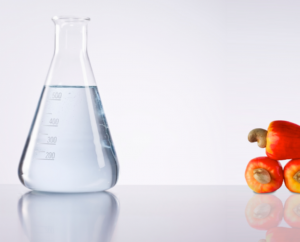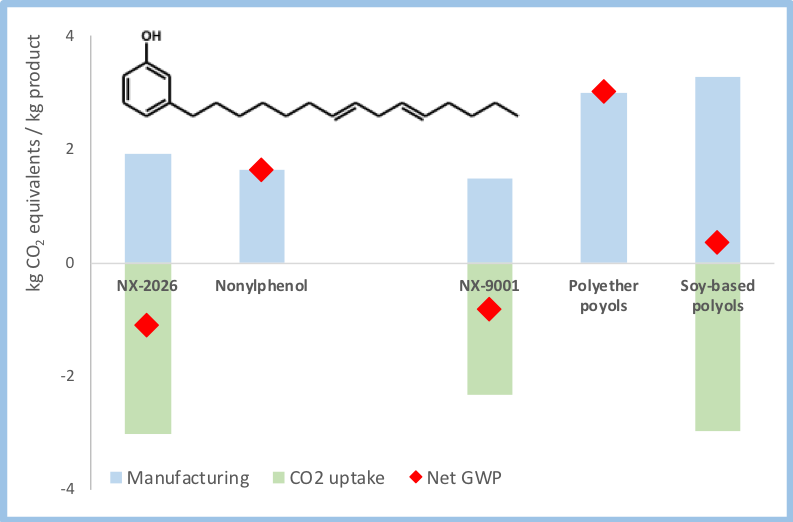Cardanol (the main component of Cashew Nut Shell Liquid, CNSL), two CNSL-based polyols, and a phenalkamine (CNSL-based epoxy curing agent) showed lower Global Warming Potential and Depletion Potential of fossil fuels than petro-based materials of similar functionalities as recent investigations of the nova-Institut GmbH in Germany concluded.
CNSL is a non-food biomaterial extracted from the shell of the cashew nut, regarded as an excellent renewable material of choice because of its inherent chemical multifunctionality, low cost and abundant availability as a byproduct in the nut industry.
 Cardolite’s CNSL-based products have been widely used in industrial formulations to enhance performance properties. According to the cradle-to-gate Life Cycle Analysis (LCA) performed by the nova-Institute, these products also contribute to a better environmental footprint.
Cardolite’s CNSL-based products have been widely used in industrial formulations to enhance performance properties. According to the cradle-to-gate Life Cycle Analysis (LCA) performed by the nova-Institute, these products also contribute to a better environmental footprint.
NX-2026 is a very high purity, ultra-light color cardanol that is used as a building block for polymers or by itself as a diluent, isocyanate blocking agent, or replacement for nonylphenol and other petro-based phenols. The recent LCA reported that the production of 1 kg of NX-2026 releases 1.92 kg of CO2 equivalents to the environment while a larger amount of CO2 is captured into the product during photosynthesis by the cashew tree Anacardium occidentale. This is equivalent to a net 1.11 kg of CO2 equivalents absorbed and removed from the environment, which is an excellent outcome since CO2 is a greenhouse gas. However, as Dr. Ángel Puente, chemist and LCA analyst points out: “It should be noted that this CO2 will be emitted back to the environment in the end of life stage of the life cycle into which NX-2026 is incorporated as part of a formulation/processing of other end-products.” On the other hand, the production of the same amount of its petro-based alternative, nonylphenol, is reported to release 1.63 kg of CO2 equivalents into the atmosphere on top of the emissions occurring during its end-of-life options, having an overall negative impact on global warming. Furthermore, NX-2026 showed much lower abiotic depletion potential (ADP) than nonylphenol, with 19.1 MJ fossil fuel resources consumed for each 1 kg of NX-2026 produced. It takes almost double the energy from fossil fuels (37.6 MJ) to produce 1 kg of nonylphenol.
Tom Claessen, Vice President of Sales at Cardolite, shared his enthusiasm with the recent LCA results. “As the world’s leader in CNSL technology, sustainability awareness is embedded in the foundation of our company. At Cardolite, we have proven for over 35 years that sustainability awareness and healthy business development can go hand in hand. In the last few years, we have seen a rewiring of the economy. More and more companies are adopting sustainability goals into their business plans and strategies. We’re pleased to see this trend and want to be a partner for those who are looking for replacing fossil-based raw materials with renewables and lowering their impact on the environment. We trust that providing these LCA data that shows the positive effect of switching from fossil-based aromatics to our bio-aromatic alternatives, can help companies developing new future-proof products.”
NX-9001 is a CNSL Novolac polyol with high bio-content and excellent hydrophobicity and fire resistance that has benefited various coatings, adhesives and foam applications. The cradle-to-gate assessment showed that the production of 1 kg of NX-9001 releases 1.49 kg of CO2 equivalents to the environment and a net absorption of 0.83 kg of CO2 equivalents from the atmosphere if carbon uptake during the cultivation of the cashew tree is considered. On the contrary, the production of the same amount of generic petro-based polyether polyols or soy-based polyols emit around 100% and 120% more greenhouse gases (GHG) respectively. Furthermore, similarly to what was observed with NX-2026, NX-9001 showed a much lower ADP of fossil fuels than non-CNSL chemistry polyols.

Please contact Cardolite through the website https://www.cardolite.com for more information about CNSL derivatives LCA results.
Source
Supplier
Cardolite Corporation
nova-Institut GmbH
Share
Renewable Carbon News – Daily Newsletter
Subscribe to our daily email newsletter – the world's leading newsletter on renewable materials and chemicals









